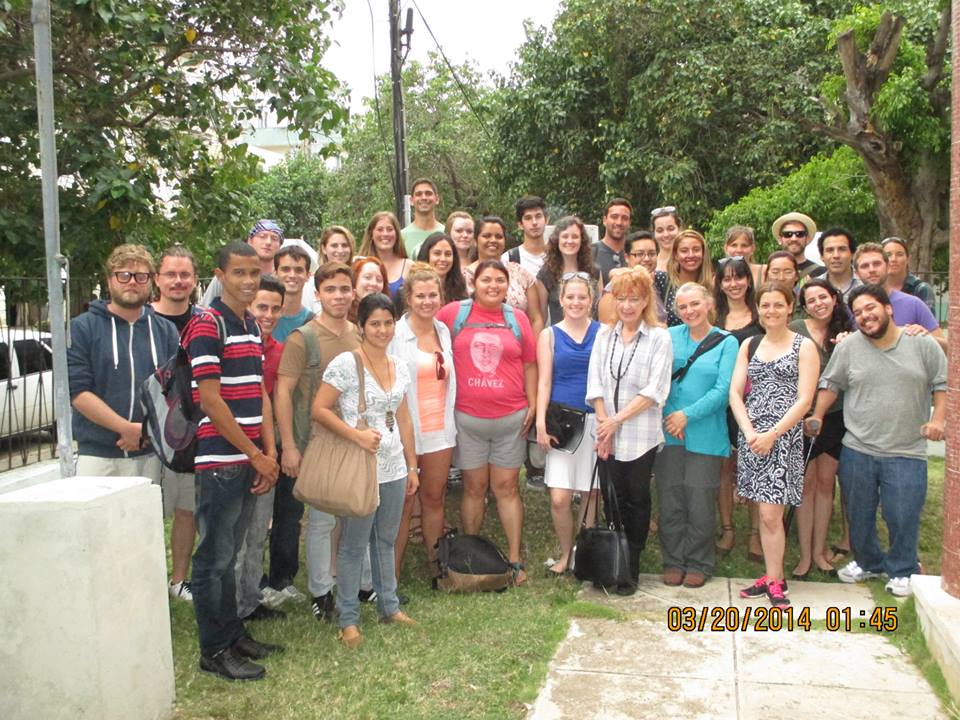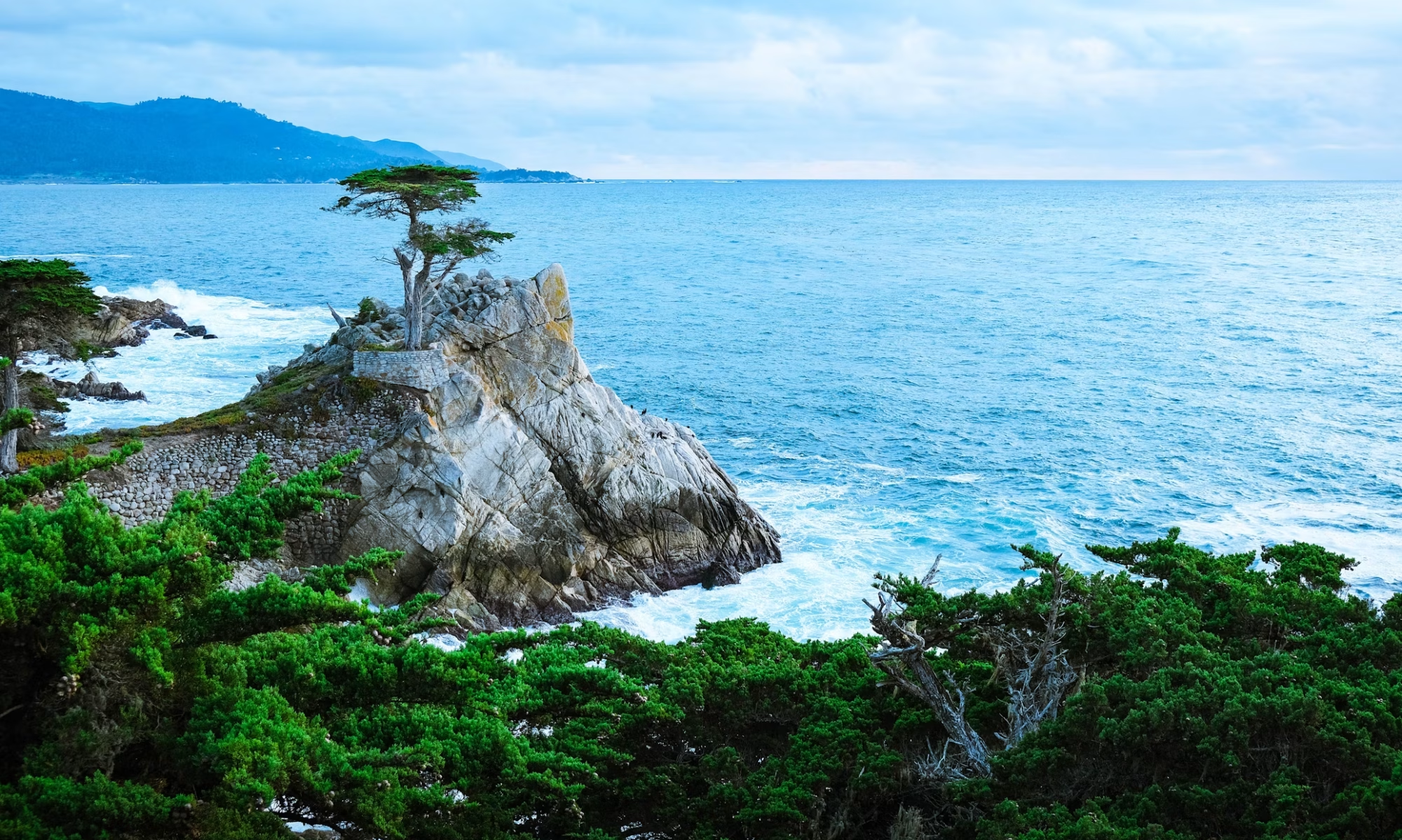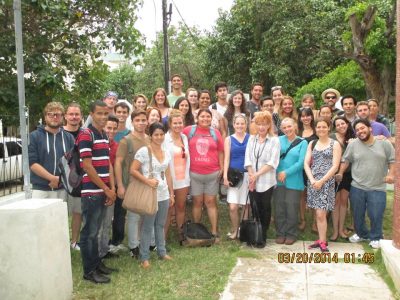Independent Practica, 2014
Baseball Diplomacy in the Americas
(“In the dark all diplomats are gray.”)
Or
Only George W. Bush Could Have Gone to Cuba
Albeit (Because)…
His Rendition of “Guantanamera” Would Have Been Extraordinary
August 3, 2014

“There is no mafia in Habana or in Cuba!”
“But, I met the Godfather in a Chinatown paladar today.”
“You met the Godfather? What was he doing in Chinatown?”
“I don’t know, but he bought me lunch.”
Who was intriguing whom on this taxi ride from the hotel to the Estadio Latinoamerica? When conversing with the local population in Cuba, one always has to take everything with a grain of salt, especially when talking to a state official, such as this cabbie. On the other hand, without a second or third party, a conversation cannot exist, and the taxi driver’s counterpart to this interlocution was a former U.S. Navy signals intelligence man, as well as a private contractor along the Blackwater lines with beaucoups experience in the field, specifically in the Arab-speaking world, specifically in Iraq, where he contracted posttraumatic stress disorder.
Was the cabbie an agent of the Dirección de Inteligencia, Cuba’s equivalent of the CIA, and possibly recording this conversation? Was the ex-serviceman still making a living off Uncle Sam’s black budget? What to believe? What to think? Whom to trust? Paranoia in the Americas is not a concept restricted to the United States or socialist states. Sometimes language barriers and the friction caused by cross-cultural interactions are a blessing in disguise.
Destination reached, the Estadio Latinoamerica was already buzzing with swarms of baseball fans, scrambling for tickets since the ballgame between the home team, Equipo Industriales, and the visitors, Equipo Pinar del Rio, already started. Located in the Cerro neighborhood of Havana and popularly known as “The Colossus of Cerro,” the Estadio Latinoamerica is the largest baseball stadium in Cuba, and home to Equipo Industriales. By far the most popular and most successful baseball team in the Serie Nacional de Béisbol (Cuba’s equivalent to U.S. Major League Baseball [MLB]), Equipo Industriales are the Cuban doppelgänger of the New York Yankees. This relationship is particularly appropriate and multi-faceted because many baseball fans in the U.S. equate the Yankees with Reagan’s conceit of the Soviet Union – “the evil empire,” and the George W. Bush administration included Cuba as a member of the exclusive political club, “the axis of evil.” However, Cuba considers “Yankees” to be U.S. imperialists, hell-bent on completely subordinating the Americas along the way to total global domination, baseball as a metaphor for contrasting interpretations of empire.
Like most places of interest in Cuba, there was a special price of admittance for foreigners at the Estadio Latinoamerica, and this price was many times higher than the subsidized entry cost for Cuban nationals. Nevertheless, visitors who paid the inflated ticket price did receive box seats in the VIP section behind home plate. In Cuba, one always gets what one pays for.
The cost discrepancy of pricing for foreigners and nationals is not unique to Cuba, for many countries in the former Soviet Union also maintain two standards of pricing, a lower subsidized price for citizens (sometimes free) and a higher (perhaps free-market) price for foreign visitors. For example, a citizen of Russia or a CIS nation can visit the Hermitage Museum in St. Petersburg at no cost, but a foreign national must a seemingly exorbitant price for entrance. What separates Cuba from these former Soviet nations apart in this regard, is the fact that Cuba maintains two official currencies. Foreigners visiting Cuba must use the Cuban Convertible peso (also known as cuc or chavito), while Cuban citizens can only use the Cuban peso. The only Cuban nationals who have access to cucs are bureaucrats, diplomats, and politicians, as well as employees in the tourist industry, the remainder of the Cuban population, must make all of their financial transactions in Cuban pesos. Almost all of the tourist attractions for Western visitors in Havana only accept cucs, but the Estadio Latinoamerica is an exception to this rule, perhaps because it is a wilder destination, somewhat beyond the pale of the normal “gringo trail” in Cuba.
Undoubtedly, the Estadio Latinoamerica is the jewel in the crown of the Serie Nacional de Béisbol, as it boasts an MLB quality field, can hold up to 55,000 spectators and is home to the Nacional de Béisbol finals and the Cuban national baseball team. For the American baseball fan, the stadium’s interior harkens back to the nostalgic days of pre-World War 2 baseball, an imagined fantastical world where hyperbole abounded, fans did not consider the greater socio-economic ramifications of the U.S. pastime, and the ballplayers played “for the love of the game.” The gaps in the stadium’s wooden rafters, the holes in the netting protecting the spectators behind home plate from sharply swatted foul balls, the sticky feel of the paved walkways trod upon the by the ghosts of millions of baseball fans, the thick billowing smoke from Cuban tobacco, and especially the rickety seats constructed from iron that force the sitting visitor into a rigid military posture all conjure up an idealized vision of a forgotten ballgame, a purity that if it ever existed disappeared from the United States many decades ago.
There is no commercial advertisement within the “friendly confines” of the Estadio Latinoamerica; there are only a few political slogans displayed in the outfield that testifies to the power of sports in continuing the revolution. Nor is there a jumbotron in outfield or pre-arranged promotional activities between innings, and there is certainly not a race where the participants consist of former U.S. Presidents similar to the race that occurs at every Washington Nationals home game (although it would be hilarious to see the Cuban baseball fan’s reaction to a race between people wearing the costumes of dead Yankee imperialist leaders). One cannot buy Crackerjacks, Budweiser (stadium authorities prohibit the sale of alcohol, but clever female fans smuggle rum inside the stadium in government issued condoms stowed in the bottoms of their handbags), or Coca-Cola, although one can buy tuKola, a Cuban cola brand produced and marketed by Cerveceria Bucanero at the special price of two cucs for foreigners). No one sings “Take Me Out to the Ballgame” or “God Bless America” during the seventh-inning stretch. Besides the actual game of baseball and the fans’ appreciation for this athletic entertainment, attending a baseball game in Cuba is a tale of how the Cuban and U.S. paths separated following the Cuban revolution, an alternate history.
Inside the Estadio Latinoamerica, the atmosphere is awash with the brightly colored attire of the Cuban baseball fans’ attire and the jarring noises coming from their air horns, which they sound vociferously, whenever the action on the diamond heats up. Attending the ballgame seems to be more akin to a night out on the town, as the majority of the fans dress as if they are heading to a nightclub, looking their best to attract someone their way. This sense of fashion is in stark contrast to what one usually witnesses at a baseball game in the U.S., where most fans wear athletic attire (except for Yankee Stadium, where you can see Wall Street players clad in Italian business suits enjoying the game and making deals from their luxury boxes in the grand tradition of the Roman Empire’s gladiatorial games) and are more interested in alcohol consumption and binge eating than the actual ballgame. After all, a ballgame is only a game, a distraction from life, entertainment, and the importance of social interaction at all levels usually triumphs regardless of the location.
In baseball, there is no clock, as nine innings bound the game’s play instead of a predefined time constriction, and a ballgame at the Estadio Latinoamerica pays even less attention to minutes and hours than an MLB game, a headfirst submersion into the Latin American sense of time. The average time for a nine-inning game in the MLB is two hours and 50 minutes, which many baseball fans consider to be too long (the American Attention Deficit Disorder), while the average time for a nine-inning game in the Serie Nacional de Béisbol is three hours and 45 minutes, almost a full hour longer than an MLB game! A Cuban baseball fan’s explanation for the lengthy length of their ballgames was that Cubans play baseball as they live their lives; with constant discussion between managers, players, and umpires, greater orientation towards the process of action rather than the results, and frequent use of the beanball as an intimidation tactic of pitchers towards batters (a dead-ball era strategy that is almost an anachronism in today’s MLB). Opposed to the constant forward drive of the plot development in an MLB game (or a Hollywood film), the action in a Cuban ballgame flows horizontally in lateral directions, unfolding rhythmically to the march of a quinto drum.
Sports have played a leading role in public diplomacy throughout history, with the tradition of promoting world peace dating back to ancient Greece, when an Olympic Truce existed every four years for the weeks of the Olympic Games. The modern Olympic Movement as conceived by Baron de Coubertin and Pierre Frédy in the late 19th century was born out of the European peace movement as a populist methodology for conducting diplomacy in an arena where state actors so frequently failed. The Olympic promotion of world peace was not always a successful diplomatic tool, most notably during the First and Second World Wars when instead of calling an Olympic Truce the International Olympic Committee called off the Games. At the end of the day, the intensity of international competition does not open diplomatic doors; rather the international exchange of athletes and the role of host cities and nations provide the most robust opportunities for sports as a form of ambassadorship.
One of the most influential instances of sports as a tool for public diplomacy occurred during the early 1970s between the U.S. and China, when members of both the U.S. and Chinese national table tennis teams engaged each other peacefully in the athletic arena despite the lack of official diplomatic relations between the two nations, thus formulating what is now popularly known as “Ping-Pong diplomacy.” Following the Chinese Civil and Chinese leader Mao Zedong’s establishment of the People’s Republic of China on October 1, 1949, the U.S. severed diplomatic ties with China while asserting that the Republic of China in Taiwan was the legitimate Chinese political authority. It was not until April 10, 1971, that an official U.S. delegation set foot on Chinese territory, when Mao personally invited the U.S. national table tennis team to visit Beijing and play against the Chinese national team in a friendly competition. The internationally publicized success of these friendly table tennis games between two nations who previously combatted each other during the Korean War paved the way for some of the most powerful U.S. political figures to visit China officially, and constructively build upon the foundations laid by this Sino-American “Ping-Pong diplomacy.”
Renown throughout the world for his virulent anti-communist political position, U.S. President Richard Nixon’s hardliner credentials reinforced his reputation as a zealot cold warrior. Thus, when Nixon along with his wife Pat and National Security Advisor Henry Kissinger officially visited China in February 1972 to transform the previous year’s “Ping-Pong diplomacy” into actual diplomacy, the U.S. media and public did not perceive these movements as acts of weakness but rather grand strategy. As result of Nixon’s visit to China and meeting with Mao, the U.S. and China normalized diplomatic relations, resolved the political status of the Taiwan, opened business and trade contracts, and reinforced to Sino-Soviet schism. Nixon’s visit to China also served as the inspiration for the American minimalist composer John Adams’ 1987 opera, “Nixon in China,” whose libretto attributes the following words to Mao: “In the dark all diplomats are gray.” This statement leads to a corollary question: “Are ambassadors of athletics, diplomats of sports also gray in the dark?” Although Nixon’s innovative diplomatic undertaking was not solely the result of “Ping-Pong diplomacy,” in this case the use of sports as a tool in public diplomacy was one of the most effective tools in the toolbox coupled with the fact that “only Nixon could have gone to China.”
As mentioned earlier, one of the strongest cultural ties shared between the U.S. and Cuba is the popularity of baseball, for baseball is the national pastime of both countries. Shortly after the Cuban Revolution, Cuba’s leader Fidel Castro severed diplomatic ties with the U.S. in 1959, and in response the U.S. placed an embargo around the U.S., prohibiting U.S. citizens and companies from conducting commerce with Cuba. The isolationist diplomatic relations between the U.S. and Cuban were not vastly unlike those between the U.S. and China preceding Nixon’s visit to China, so why not try what worked before to normalize Sino-American relations, sports as public diplomacy, but in this situation use baseball upon which to reconstruct relations rather than table tennis. Seeking to expand upon the success of “Ping-Pong diplomacy,” U.S. Senator from Massachusetts and the Democratic Candidate for U.S. President in the 1972 elections, George McGovern, suggested this option of “baseball diplomacy” in the 1970s as an attempt to normalize U.S.-Cuban relations, but the U.S. Department of State blocked his proposal.
It was not until the waning years of the Clinton administration in 1999, that the U.S. government allowed a U.S. MLB team, the Baltimore Orioles, to travel to Cuba and play one game against the Cuban national team, followed by a visit to Baltimore by the Cuban national team to play the Orioles. This two-game series between the Orioles and the Cuban national team was permitted to take place, only because the Clinton administration loosened policy towards Cuba, allowing for an increase in academic, cultural, and professional exchanges between the two nations. The Orioles defeated the Cuban national team in Havana, but the Cuban national team defeated the Orioles in Baltimore, and one Cuban national team member defected to the U.S. Regardless of the results of the ballgames played, for the first time in almost forty years, Americans were interacting with Cubans in Cuba and Cubans were interacting with Americans in the U.S. Perhaps this “baseball exchange” was the basis for constructing a new dialogue between the opposing nations, vis-à-vis “Ping Pong diplomacy,” which would lead to the end of the embargo and the normalization of U.S.-Cuban relations.
With the coming of the twenty-first century, there was great hope that the U.S. and Cuba could resolve their differences and step into the new century together in the spirit of democracy and friendship, but then the controversial Elian Gonzalez affair occurred in 2000. In November 1999, Elian Gonzalez’ mother and her boyfriend took Elian in an attempt to defect to the U.S. from Cuba by means of a small boat, but Elian’s mother drowned en route. Anglers rescued Elian from the boat and turned him over to U.S. authorities, who later placed him under the care of his paternal relatives in Miami, Florida. Elian’s Miami relatives sought to keep him in the U.S. in spite of the petition lobbied by Elian’s father to return Elian to his care in Cuba. A media storm ensued in late spring 2000, amidst the U.S. Presidential Elections, with Al Gore, the Democratic candidate, supporting Elian’s return to Cuba, and George W. Bush, the Republican candidate whose brother was governor of Florida, the home of the influential single issue anti-Castro Cuban diaspora, advocating for Elian’s stay in the U.S. Ultimately, the U.S. Supreme Court decided not to hear Elian’s case, and U.S. authorities returned Elian to Cuba in June 2000, despite the vociferous protests of the Cuban diaspora community in the greater Miami area.
The Elian Gonzalez affair was an influential factor that contributed to the controversial results of the 2000 U.S. Presidential Election in the state of Florida that ultimately led to the election of George W. Bush as the 43rd President of the United States, despite his loss of the general election. Although President Bush maintained a strong anti-Castro and Cuba position, he was a baseball fan and formerly owned an MLB franchise, the Texas Rangers, before entering politics. Thus, a sliver of hope existed that Bush might have sought to build upon the “baseball diplomacy” of 1999 and initiate a dialog with Castro, just as Nixon and Kissinger used “Ping-Pong diplomacy” as a bridge to Nixon’s visit to China and the subsequent opening of China. Instead of emulating his Republican presidential predecessor Nixon’s bold diplomatic maneuvers in relation to an enemy state, Bush opted to move reactively in order to appease the neoconservatives inside the beltway and solidify his Florida-based electorate, by strengthening the terms of the U.S. embargo and sanctions on Cuba, and more specifically by granting Cuba membership in the prestigious political group of nations, “the axis of evil.” Moreover, as a neoconservative Republican hawk, Bush like Nixon did possess the correct hardliner political credentials to go to Cuba, just as Nixon went to China, without the U.S. media or public considering this action as capitulation and weakness. Bush elected to implement a reactionary approach lacking creativity or imagination in his foreign affairs policy-making that resulted in a great opportunity lost, and prevented him from securing a diplomatic victory such as Nixon’s in China. In the end, only Bush could have gone to Cuba yet he did not, but if Bush had gone to Cuba, undoubtedly his rendition of Guantanamera would have indeed been extraordinary.




You must be logged in to post a comment.